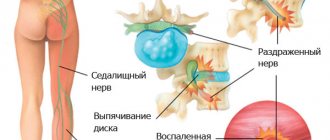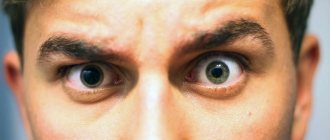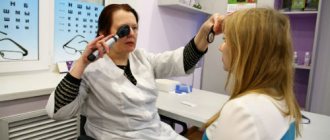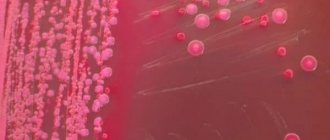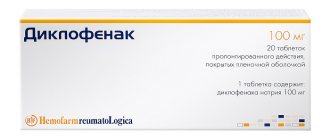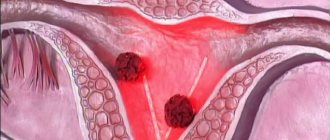05/19/2019 Radiculitis, also known as sciatica, has modernized its name and, after “rebranding,” began to be called sciatic nerve neuropathy. For those who have encountered this disease, a much more important question is how to cure inflammation of the sciatic nerve, because it is the inflammatory process, damage and pinching that causes pain and deterioration in health. According to statistics, approximately a tenth of adults experience damage to the nerves located in the lumbosacral spine.
The ischial spine is the longest in the human body: it starts in the lower back and goes to the toes, branching along the way. Since the location is quite extensive, any nerve damage is reflected in the lower back and spreads to the entire back surface of the leg. The nature of the pain can be different:
- piercing;
- pressing;
- sore;
- aching;
- aching;
- burning;
- cutting.
In addition, a person slowly loses the sensitivity of the limb, up to complete loss. Practice shows that doctors more often deal with unilateral lesions.
Inflammation and pinching of the sciatic nerve is the competence of a neurologist, whose recommendations are implemented by a physiotherapist, massage therapist, specialist in alternative methods of treatment, and chiropractor. A consultation with an oncologist or neurosurgeon may be necessary. If the clinic has a rheumatologist, vertebrologist or vascular surgeon on staff, the therapist can refer you to them.
Why does pathology occur?
Doctors consider primary and secondary neuropathy. The primary cause is injuries, infectious diseases and hypothermia. The list of reasons that can cause a secondary type of illness is much more extensive. These include:
- disc displacement;
- neoplasms of any nature;
- osteochondrosis;
- protrusion;
- osteophytes;
- spasmodic muscles;
- curvature of the ridge;
- tunnel syndrome;
- intervertebral hernia;
- post-injection suppuration.
Symptoms of inflammation of the sciatic nerve
Pain, which can even occur due to lifting a heavy bag or hypothermia, night attacks are the main indicator of sciatica. In addition to the sharp shooting pain syndrome, doctors advise paying attention to:
- “pins and needles” and numbness from the buttocks and below;
- constipation, urinary incontinence;
- weakness and gradual muscle atrophy, limping.
When a person moves or stands for a long time, pain is more disturbing. During attacks, redness of the skin, swelling, chills, and sweating are quite possible. At first, the pain syndrome is not very expressive, but gradually becomes so strong that there is a danger of loss of consciousness. It almost hurts for a person to breathe. If the disease is not treated, the entire leg will suffer: it will become cold, bending and unbending it will be problematic, and then the ability to move the foot and toes will be lost.
Symptoms
As a rule, with lumbar ischialgia, symptoms occur on one side, and the pain starts from the lower back and goes down the back of the thigh down to the foot.
- Pain in the lower back is usually less intense than in the leg.
- Pain, as a rule, on one side of the lower back with irradiation into the buttock or thigh along the sciatic nerve - along the back of the thigh, lower leg and foot.
- The pain decreases when the patient lies down and when walking and intensifies when standing or sitting.
- The pain is acute and burning in nature.
- Some patients may describe a feeling of tingling, numbness, or weakness in the leg.
- Weakness or numbness when moving your leg.
- Severe or shooting pain in the leg that may make it difficult to stand or walk.
- Depending on the location of the effect on the sciatic nerve, pain may also occur in the foot and toes.
Symptoms of lumbar ischialgia depend on where the root compression occurs.
For example:
- L4 root - Symptoms will usually appear on the hip. Patients may experience weakness when straightening the leg and possibly a decreased knee reflex.
- L5 root – symptoms may occur in the big toe and ankle. Patients may feel pain or numbness in the top of the foot (between the big and second toe).
- S1 root – symptoms may appear on the outer part of the foot, radiating to the toes and little toe. Patients may experience weakness when lifting the foot or trying to stand on tiptoes. There may also be decreased ankle reflexes.
When several roots are compressed, a combination of symptoms is possible.
There are a number of symptoms that deserve special attention, as they require emergency medical attention, sometimes even surgical intervention. These symptoms are:
- Symptoms that continue to worsen rather than improve may indicate possible nerve damage, especially if neurological symptoms have progressed (eg, weakness in the leg).
- Symptoms of lumbar ischialgia occur in both legs and there are signs of bowel or bladder dysfunction, which may be a sign of cauda equina syndrome. For cauda equina syndrome, emergency surgery is indicated.
If you have these symptoms, you should immediately seek medical help.
Pinching symptoms
Doctors consider several syndromes that indicate that the patient has a pinched nerve.
- Lesera – straight leg does not rise;
- Sikara – pain intensifies if a person bends the foot;
- landing - it is impossible to take a sitting position yourself.
It hurts to walk and squat, but if you lie down or sit with your legs spread wide apart, it goes away. Signs of inflammation and pinching of the sciatic nerve are quite expressive, but they can still be confused with other diseases:
- spondylitis;
- myeloma;
- ankylosing spondylitis;
- phlebothrombosis;
- arterial insufficiency.
Causes of sciatica
Since we have touched on the causes of the disease, it would be appropriate to outline their most complete list.
Pinching of the sciatic nerve is often provoked by performing sudden and unnatural body movements, staying in an uncomfortable position for a long time, physical inactivity, and powerful physical activity on the lumbar region. In addition, the causes of the disease are often hidden in unexpected muscle spasms in the direction of the designated nerve, prolonged exposure to cold and dampness in inappropriate clothing, or the presence of any pathology in the patient. Among them:
- herniation or protrusion of intervertebral discs;
- osteochondrosis in the sacrolumbar region;
- gout;
- spinal injuries (especially if they resulted in its displacement);
- damage to muscle fibers in the buttocks and upper legs;
- abscesses;
- benign and malignant neoplasms localized in close proximity to the sciatic nerve;
- displacement of one vertebra relative to another (neighboring);
- thinning of the spinal canal;
- diabetes;
- pelvic inflammation, septic diseases;
- multiple sclerosis;
- infectious diseases (for example, whooping cough, influenza and malarial manifestations, bone tuberculosis, rubella, etc.);
- herpes zoster;
- thrombosis;
- poisoning (especially alcoholic and neurotropic, as well as the negative effects of tobacco smoke, heavy metals);
- vitamin deficiency, lack of micronutrients and minerals.
Pregnant women are in the risk group for the disease. Since the enlarged uterus puts considerable pressure on nearby organs and overloads the spine, sometimes the sciatic nerve becomes pinched. Sometimes sciatica is provoked by the fact that the expectant mother abuses being in positions that are uncomfortable for her, wears narrow shoes, ignoring the discomfort and pain. Therefore, the need for comfort for a representative of the fair sex who is in an interesting position is not just a banal whim, but reasonable self-care. Menopause is another stage for a woman that increases the risk of sciatica, since it is characterized by serious internal changes.
How to make a diagnosis
The disease is determined by a neurologist based on the results of motor tests that reveal the presence of the syndromes described above. But laboratory and instrumental studies are still necessary. As a rule, they are limited to x-rays in two planes. It may be necessary to obtain a more clear picture of the condition of the spine. In this case, a tomography will be prescribed. A radioisotope scan is done if a tumor is suspected.
When a person has inflammation of the sciatic nerve, treatment at home is not always acceptable, because the disease can manifest itself in such a serious form that the patient is prescribed bed rest in a hospital setting. Nerve-related illnesses must be taken seriously or you may lose your ability to move.
An immediate visit to a doctor is necessary in the following cases:
- severe numbness that prevents you from moving;
- increased body temperature;
- transfer of pain to other locations;
- incontinence of metabolic products;
- swelling in the lower part of the ridge.
How to treat inflammation of the sciatic nerve
Treatment measures are aimed at:
- relieving the patient of pain;
- improved sensitivity of the limbs;
- restoration of leg functionality.
To achieve this, they resort to methods of traditional and alternative medicine. Treatment begins with pain relief. Then physiotherapy, therapeutic exercises, and manual therapy come into play. In parallel, the rich experience of traditional medicine can be used.
Medicines prescribed for the treatment of sciatica include the following groups of drugs:
- non-steroidal;
- corticosteroids;
- vitamin complexes;
- biogenic stimulants;
- muscle relaxants;
- decongestants;
- angioprotectors.
External means are widely used - warming creams and ointments, which contain snake or bee venom, hot pepper, camphor, turpentine. Massage for inflammation of the sciatic nerve helps improve blood circulation and restore muscle tone.
A huge role in restoring leg functions belongs to physiotherapeutic procedures, for example, magnetic and laser therapy, electrophoresis, and dynamic current treatment. Various types of physical exercises, selected for a specific patient, reduce muscle spasms and strengthen the body.
To heal at home, you will have to be patient, since sciatica responds better to the efforts of professionals. There are cases when the disease started precisely because of insufficiently active therapeutic measures. The more complex the case, the more effective drugs have to be prescribed. So, if non-steroidal drugs do not help, although a person takes them for a long time, steroid drugs are prescribed, which have significant side effects.
In many clinics, in addition to the main treatment, patients undergo courses:
- acupuncture;
- ozone therapy;
- herbal medicine;
- cupping and vacuum massage;
- stone therapy;
- treatment with leeches;
- cauterizations.
Many recipes for compresses, lotions, and tinctures have been developed. But it is better not to try them on yourself without consulting your doctor. The doctor knows where and how they can help or harm. Therefore, it is necessary to consult.
Spa and hydrotherapy is an excellent way to improve overall health and regulate various pathologies, including inflammation of the sciatic nerve, the symptoms and treatment of which, due to their diversity and complexity, require long-term and careful attention.
If therapeutic methods do not produce results, the nerve has to be decompressed. This is done surgically.
It is not enough to know how to treat sciatica, that is, inflammation of the sciatic nerve. It is necessary to be aware of how to protect yourself from such a serious, life-spoiling and health-robbing illness.
Among the preventive measures, doctors recommend the following:
- do not freeze;
- strengthen immunity;
- lift weights correctly;
- develop posture;
- sleep on hard mattresses;
- beware of sudden movements.
A healthy body significantly increases the likelihood that the spine will work correctly, and the nerve roots will avoid inflammation and will not be pinched.
We specialize in the treatment of the musculoskeletal system, even in severe stages of disease. We have been helping thousands of patients avoid surgery for 10 years!
Our doctors
This is the strongest team of experts who teach at the RUDN Department. We are the clinical base of leading universities, where the best doctors in Moscow, unique specialists from Russia and abroad are trained.
Osteopathic treatment for sciatica
Osteotherapy is an amazing medical field that allows you to overcome sciatica without resorting to surgery or medications. It perceives a person as a whole, reveals the subtlest deep relationships within him and, getting to the true essence of the problem, eliminates it, thereby relieving pain and any other uncomfortable symptoms of the disease.
An osteopathic doctor can relax cramped muscles, reduce inflammation, and return displaced vertebrae and joints to their place. The treatment in question triggers the self-healing functions that lie dormant within each of us and has a positive effect on the general well-being of the patient. His pain goes away, his posture and complexion improve, and his sleep normalizes.
For some, it is extremely important that the treatment does not cause discomfort; others are afraid to use medications or have difficulty tolerating them.
You can forget about these fears by contacting an osteopathic doctor.
Osteopractic sessions are easy and most often painless. Some say they resemble a massage, while others compare them to magic. This is true medicine that works real miracles. The sensitive and caring attitude of our Center’s specialists towards patients under their care, as well as their high professionalism and invaluable work experience, contribute to the fact that treatment is gaining rapid positive dynamics.
The patient recovers quickly, he does not have to take a huge amount of expensive medications or go under the knife to a surgeon.
However, osteotherapy does not exclude pharmacological therapy if there is a desire or need.
In particular, specialized ointments will help reduce inflammation and pain, easing the course of the disease on the path to healing. An entire section of alternative medicine, called homeopathy, is engaged in the development of remedies suitable for use for medicinal purposes for the above-mentioned disease.
The homeopathic doctor at the Osteopathy Center individually selects the necessary medications, making the treatment of our clients complex and comprehensive.
Osteomedicine has virtually no contraindications. It can be used to eliminate sciatica at any age, as well as during pregnancy. In the latter situation, among other things, osteopractice will help normalize blood flow, which will have a positive effect on the condition of the unborn baby, as well as on his life activity in the future.
Depending on the essence of the problem and the individual characteristics of the patient, the doctor uses certain techniques to overcome the disease.
Along with classical osteopractice techniques, manual osteotherapy gives good results.
She specializes in deep study of the insides, the fight for the healing of the spinal column.
Manual osteomedicine helps to heal pain associated with hernia formations, stopping their development and even promoting their regression.
The chiropractor works with muscle fibers, tensing and relaxing them, and also carries out rhythmic movements of the joints of his client, performing various twists and stretches.
The client usually does not experience any pain at all.
Acupuncture, or, as they say now, reflexology, is a reliable assistant that helps overcome illness, eliminating pain and improving well-being.
Activation of special points on the human body allows you to increase blood supply and metabolism, restore neural conduction in the area affected by inflammation.
Acupuncture is an excellent alternative to anesthetics; it can be used to relieve pain without using these medications.

